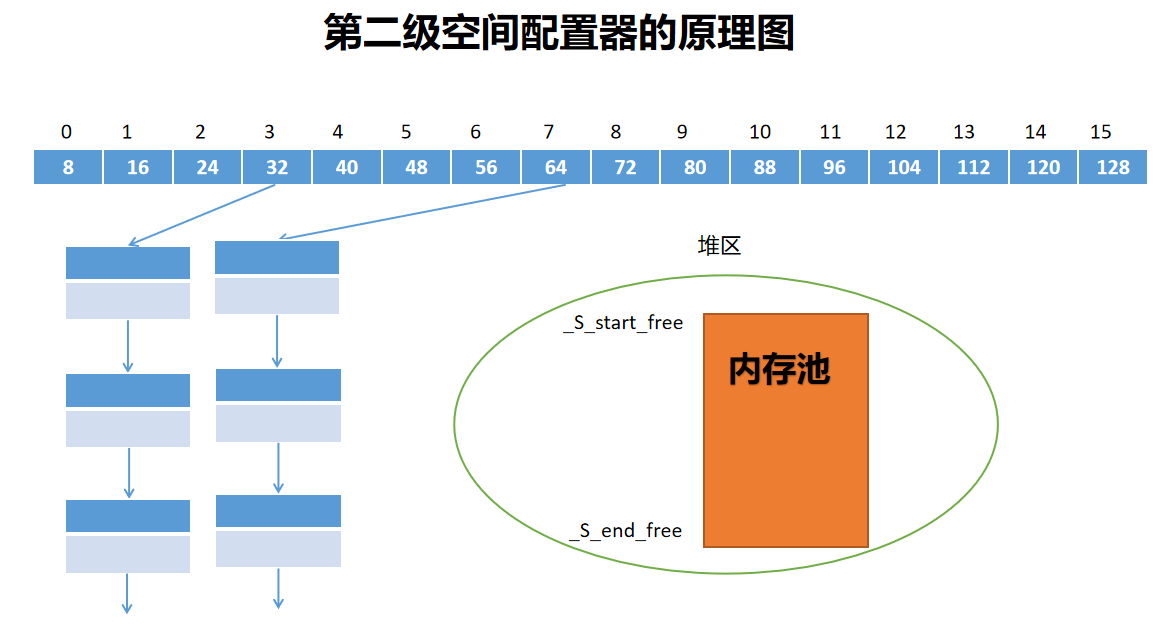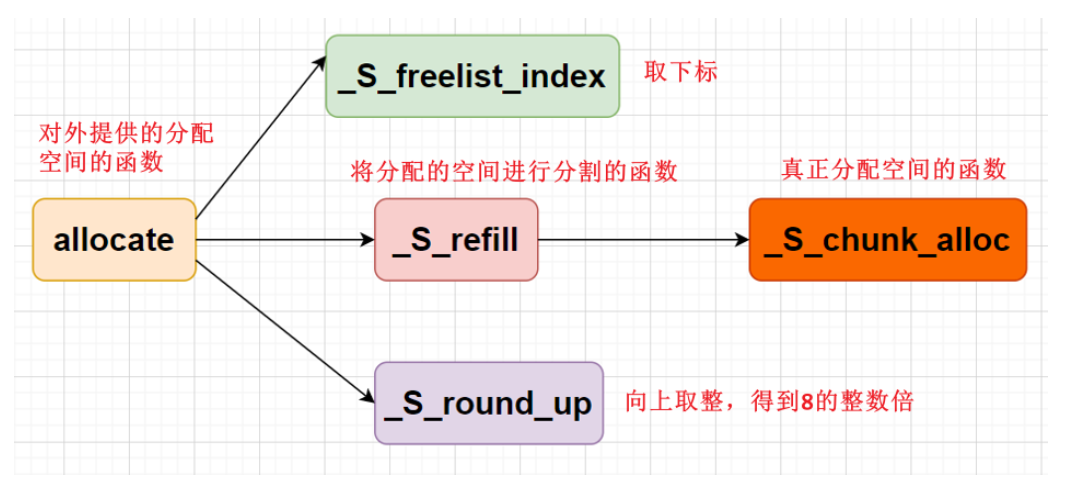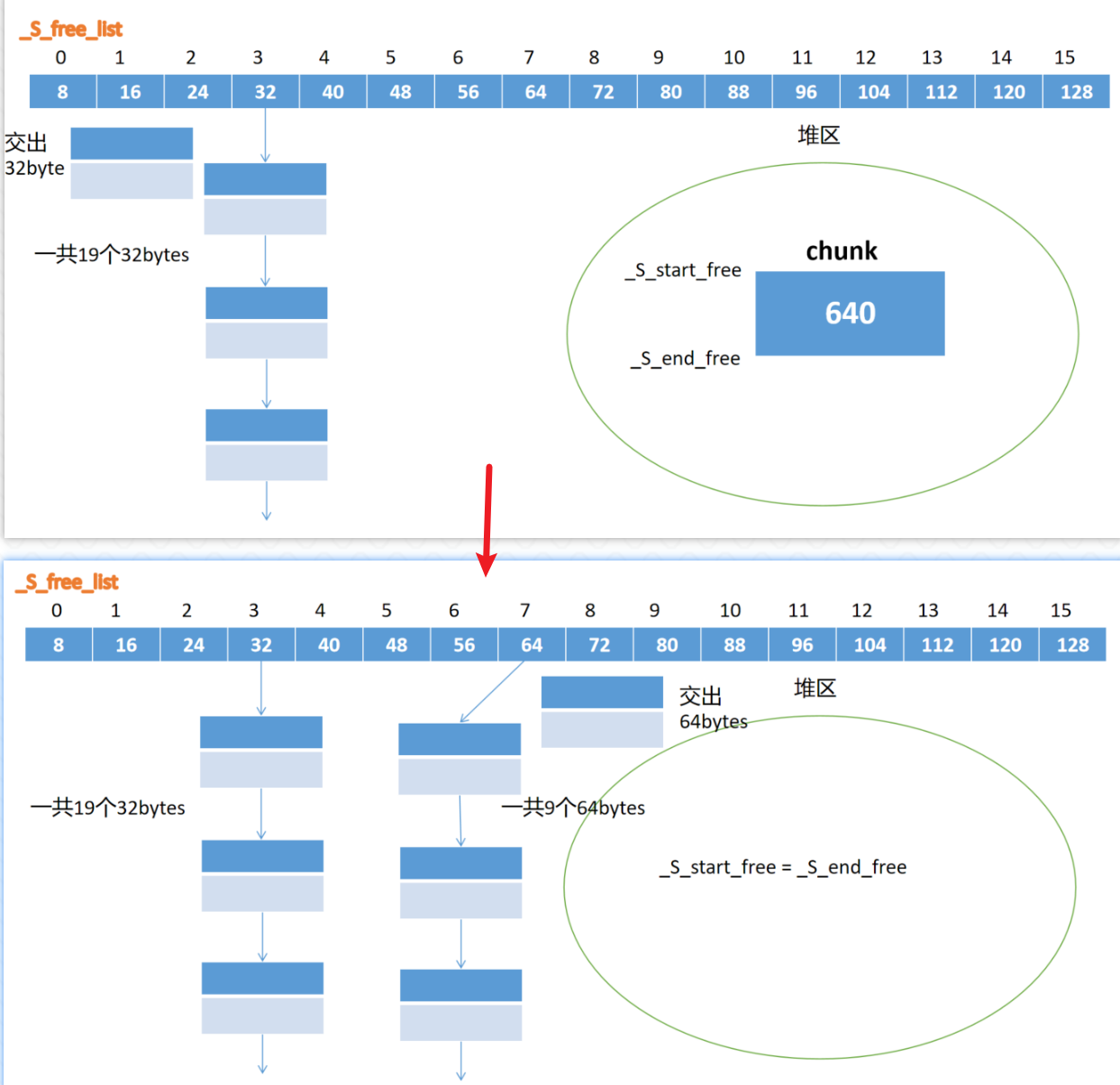allocator的基本概念
在C++中所有STL容器的空间分配其实都是使用的std::allocator
std::allocator是可以感知类型的空间分配器,将空间的申请与对象的构建、以及空间的回收与对象的销毁严格分离。
以前我们知道使用new创建单个对象的时候,空间的申请与对象的构造实际也是分开的(可以回顾new表达式的工作步骤)。
那么为什么要将空间的申请与对象的构建分开呢?
减少不必要的对象构造和析构:在容器的使用过程中,有时只是需要预留一些空间,而并不需要立即在这些空间上构造对象。例如,
std::vector的reserve函数,它的作用是为容器预留足够的内存空间,但不会构造任何对象。如果不将空间申请和对象构建分开,每次预留空间时都会构造对象,之后又可能因为不需要这些对象而进行析构,这会带来不必要的性能开销。方便实现复杂的容器操作:在实现容器的一些操作,如插入、删除元素时,将空间申请和对象构建分开可以更方便地处理各种情况。例如,在插入元素时,如果当前空间不足,容器可以先申请新的空间,然后将原有元素移动到新空间,最后在合适的位置构造新的对象,这样的操作更加灵活和高效。(比如
vector的动态扩容机制背后就使用了空间配置器)
常用成员函数
xxxxxxxxxx111//申请空间2T* allocate( std::size_t n );3
4//释放空间5void deallocate( T* p, std::size_t n );6
7//构建对象8void construct( pointer p, const_reference val );9
10//执行析构11void destroy( pointer p ); //p->~T()底层实现
原理
空间配置器会分为两级:
一级空间配置器使用类模板malloc_alloc_template ,其底层使用的是malloc/free进行空间的申请与释放;
二级空间配置器使用类模板default_alloc_template(默认空间配置器),其底层根据申请空间大小又分为两个分支,第一分支是当申请的空间大于128字节的时候,还是走malloc_alloc_template ,当申请的空间小于128字节的使用,使用内存池 + 自由链表的方法申请空间。
注意:这里提到的自由链表实际是一个容量为16的指针数组,在源码中使用了_S_free_list这个名字,直译为自由链表
有一个容量为16的指针数组,每个元素(指针)指向一个链表 ,用于管理不同大小的内存块。这 16 个指针所指向的链表,分别对应 8、16、24、32、40、48、52、64、72、80、88、96、104、112、120、128 字节的内存块。
每当程序申请小于 128 字节的内存时,二级空间配置器会先将申请的内存大小上调为 8 的倍数,再根据上调后的大小(8的整数倍)找到对应的链表。
比如:
数组中下标为3的指针,代表着会按照8 * (3 + 1) = 32字节为基本单位申请空间。
第一次申请32个字节空间的时候,一次性申请很大一片空间(比如32 * 20 = 640个字节),然后按照32字节为一个等分,分成多个等分,然后挂接在下标为3的指针下面,形成链表形式。
以后需要32字节的时候,直接在下标为3的下面取出一个节点即可,就是32个字节的内存空间。
如果申请64字节空间,第一次申请时也申请很大一片空间,同样按照64字节为一个等分,分成多个等分,挂载在数组中下标为7的指针之下。
以后如果需要申请64字节时,就在下标为7的下面取出一个节点即可。
其他下标的处理方式完全一致。
自由链表的工作示意图如下,第一次申请空间时比较麻烦,后续再此申请同等大小的空间可以以O(1)的时间复杂度完成申请。

这么干有什么意义呢,为什么不每次直接申请相应大小的空间?
如果频繁申请小片空间,可能会出现内存碎片的问题,这样导致空间的利用率低;
会在内核态与用户态之间进行频繁的切换,时间消耗也比较大。
源码
由头文件<memory>找到<stl_alloc.h>
xxxxxxxxxx201template <class _Tp>2class allocator {3 // 了解到_Alloc类型别名4 typedef alloc _Alloc;5
6public:7 _Tp *allocate(size_type __n, const void * = 0) {8 // 如果申请空间大小不为0,调用_Alloc的静态成员函数allocate9 // 如果申请空间大小为0,返回空指针10 return __n != 0 ? static_cast<_Tp *>(_Alloc::allocate(__n * sizeof(_Tp))) : nullptr;11 }12
13 void deallocate(pointer __p, size_type __n) {14 _Alloc::deallocate(__p, __n * sizeof(_Tp));15 }16
17 void construct(pointer __p, const _Tp &__val) { new (__p) _Tp(__val); }18
19 void destroy(pointer __p) { __p->~_Tp(); }20};继续查看类型别名原本的定义
xxxxxxxxxx21typedef malloc_alloc alloc;2typedef __malloc_alloc_template<0> malloc_alloc;xxxxxxxxxx111template <int __inst>2class __malloc_alloc_template {3public:4 static void *allocate(size_t __n) {5 // 其实底层就是使用了malloc6 void *__result = malloc(__n);7 if (nullptr == __result)8 __result = _S_oom_malloc(__n); // 申请失败的情况9 return __result;10 }11};这就是一级空间配置器
回到typedef alloc _Alloc; 查找alloc时还有第二个分支
xxxxxxxxxx111// 另一个分支的alloc类2typedef __default_alloc_template<__NODE_ALLOCATOR_THREADS, 0> alloc;3
4// 相当于5
7typedef malloc_alloc alloc;8
9typedef __default_alloc_template<__NODE_ALLOCATOR_THREADS, 0> alloc;11查看__default_alloc_template的定义(下面对源码进行了一定的简化)
也就是二级空间配置器
xxxxxxxxxx341// 主要查看静态成员函数allocate的定义2template <bool threads, int inst>3class __default_alloc_template {4 enum { _ALIGN = 8 };5 enum { _MAX_BYTES = 128 };6 enum { _NFREELISTS = 16 };7
8 /* __n must be > 0 */9 static void *allocate(size_t __n) {10 void *__ret = nullptr;11
12 if (__n > 128) { // if (__n > (size_t) _MAX_BYTES){13 //__ret = malloc_alloc::allocate(__n);14 // 又回到刚才的情况了,等价于就是调用了malloc15 __ret = malloc(__n);16 } else {17 // 这一步很关键,跳转查看_S_free_list和_S_freelist_index18 // 从数组开始位置偏移相应长度,接下来可以在这个位置之下挂载内存块节点19 //20 // 假设arr是一个存着int*元素的数组 int * arr[16] = {0}21 // arr int** + 3 就得到了数组中第四个元素的地址22 _Obj **__my_free_list = _S_free_list + _S_freelist_index(__n);23
24 _Obj *__RESTRICT __result = *__my_free_list;25 if (__result == 0)26 __ret = _S_refill(_S_round_up(__n));27 else {28 *__my_free_list = __result->_M_free_list_link;29 __ret = __result;30 }31 }32 return __ret;33 };34};对于_S_free_list,最终其类型为_obj*[16]
xxxxxxxxxx151static _Obj *_S_free_list[];3// Specifying a size results in duplicate def for 4.14 static _Obj* _S_free_list[16]; 6
7template <bool __threads, int __inst>8typename __default_alloc_template<__threads, __inst>::_Obj* __STL_VOLATILE9__default_alloc_template<__threads, __inst> ::_S_free_list[10 _NFREELISTS12 __default_alloc_template<__threads, __inst>::_NFREELISTS14] = {0, 0, 0, 0, 0, 0, 0, 0, 0, 0, 0, 0, 0, 0, 0, 0, };对于_S_freelist_index(__n)
xxxxxxxxxx51// 假设申请32字节,这里传入的参数就是322static size_t _S_freelist_index(size_t __bytes) {3 //(32 + 8 - 1)/8 - 1 = 4 - 1 = 3 32字节对应数组中下标为3的位置4 return (((__bytes) + (size_t)_ALIGN - 1) / (size_t)_ALIGN - 1);5}作用:根据申请内存的大小取其对应于指针数组(自由链表)中的下标
刚才的allocate函数中申请空间大小小于128的分支就可以这样来进行理解
xxxxxxxxxx151// 假设申请32字节,__n = 322//_S_freelist_index(32) = 33// 类似于int* arr[16] = {0};4// int **p = arr + 3;5_Obj **__my_free_list = _S_free_list + _S_freelist_index(__n);6
7// 一开始_S_free_list里存的全都是空指针8//__result = nullptr;9_Obj *__RESTRICT __result = *__my_free_list;10if (__result == nullptr)11 __ret = _S_refill(_S_round_up(__n)); // 跳转查看_S_round_up,再跳转查看_S_refill12else {13 *__my_free_list = __result->_M_free_list_link;14 __ret = __result;15}_S_round_up函数
xxxxxxxxxx251static size_t _S_round_up(size_t __bytes) //__bytes = 322{3 //(32 + 8 - 1) & ~(8 - 1) = 39 & ~7 按位与4 // 39 = 32 + 4 + 2 + 1 ====> 0010 01115 // 7 = 4 + 2 + 1 ====> 0000 0111 再取反 ~7 = 1111 10006 // 39 & ~7 = 0010 0000 =====> 就是327 return (((__bytes) + (size_t)_ALIGN - 1) & ~((size_t)_ALIGN - 1));8}9
10// 传入的参数是32,返回值也是32,好像有点没必要,那么试试如果传进来的是3111//(31 + 8 - 1) & ~(8 - 1) = 38 & ~7 按位与12// 38 = 32 + 4 + 2 ====> 0010 011013// 7 = 4 + 2 + 1 ====> 0000 0111 再取反 ~7 = 1111 100014// 38 & ~7 = 0010 0000 =====> 也是3215
16// 如果传入的是3317//(33 + 8 - 1) & ~(8 - 1) = 40 & ~7 按位与18// 40 = 32 + 8 ====> 0010 100019// 7 = 4 + 2 + 1 ====> 0000 0111 再取反 ~7 = 1111 100020// 40 & ~7 = 0010 1000 =====> 4021
22// 不妨多试一下参数23// 25 ---> 3224// 24 ---> 2425//...作用:这个函数实现的就是向上取整得到8的整数倍
_S_refill函数
xxxxxxxxxx341// 仍然根据刚才的假设走,此时传入参数__n = 322void *__default_alloc_template<__threads, __inst>::_S_refill(size_t __n) {3 int __nobjs = 20;4 //_S_chunk_alloc实际申请了2 * 20 * 32 = 1280字节空间5 //__chunk会指向前640字节的空间的首地址6 char *__chunk = _S_chunk_alloc(__n, __nobjs); //_S_chunk_alloc这个函数才是真正去申请了空间的函数7
8 _Obj *__STL_VOLATILE *__my_free_list;9 _Obj *__result;10 _Obj *__current_obj;11 _Obj *__next_obj;12 int __i;13
14 if (1 == __nobjs)15 return (__chunk);16
17 // 在数组中偏移到下标3位置,接下来32字节的内存块都挂载到这个位置之下18 __my_free_list = _S_free_list + _S_freelist_index(__n);19
20 /* Build free list in chunk */21 __result = (_Obj *)__chunk; // 指向640个字节的最开始,强转成_Obj*类型指针,并且__result作为了最后的返回值,实际上就是把32字节的空间交出来了22 *__my_free_list = __next_obj = (_Obj *)(__chunk + __n); // 从640字节内存首地址偏移32字节,强转成_Obj*类型指针,并用数组中的第四个指针(下标3)进行指向23 for (__i = 1;; __i++) {24 __current_obj = __next_obj;25 __next_obj = (_Obj *)((char *)__next_obj + __n); //__next_obj再偏移32字节26 if (__nobjs - 1 == __i) { // 20 - 1 != 1,走else分支 —— 要循环19次,最终把剩下的19 * 32字节切割成32字节等分,一步一步挂载起来27 __current_obj->_M_free_list_link = 0;28 break;29 } else {30 __current_obj->_M_free_list_link = __next_obj; // 用链表连接的方式,从(640-32)剩下的内存块中又切割出32字节31 }32 }33 return (__result);34}作用:将调用_S_chunk_alloc所返回的640字节以32字节为一个等分,分成20等分,第一等分交给__result直接作为返回值,剩下的19个32字节会以链表的形式挂接在数组中下标为3的元素之下。
_S_chunk_alloc函数
xxxxxxxxxx661template <bool __threads, int __inst>2char *3__default_alloc_template<__threads, __inst>::_S_chunk_alloc(size_t __size, // 324 int &__nobjs) // 205{6 char *__result;7 size_t __total_bytes = __size * __nobjs; // 6408 size_t __bytes_left = _S_end_free - _S_start_free; // 0 第二次变成12809
10 if (__bytes_left >= __total_bytes) {11 __result = _S_start_free; // 将1280字节的空间交出了640个字节12 _S_start_free += __total_bytes; //_S_start_free和_S_end_free之间只剩640字节空间13 return (__result);14 } else if (__bytes_left >= __size) {15 __nobjs = (int)(__bytes_left / __size);16 __total_bytes = __size * __nobjs;17 __result = _S_start_free;18 _S_start_free += __total_bytes;19 return (__result);20 } else {21 // 第一次得到了__bytes_to_get = 128022 size_t __bytes_to_get =23 2 * __total_bytes + _S_round_up(_S_heap_size >> 4);24 // Try to make use of the left-over piece.25 if (__bytes_left > 0) {26 _Obj *__STL_VOLATILE *__my_free_list =27 _S_free_list + _S_freelist_index(__bytes_left);28
29 ((_Obj *)_S_start_free)->_M_free_list_link = *__my_free_list;30 *__my_free_list = (_Obj *)_S_start_free;31 }32
33 _S_start_free = (char *)malloc(__bytes_to_get); //_S_start_free指向1280字节的首地址34
35 if (0 == _S_start_free) {36 size_t __i;37 _Obj *__STL_VOLATILE *__my_free_list;38 _Obj *__p;39 // Try to make do with what we have. That can't40 // hurt. We do not try smaller requests, since that tends41 // to result in disaster on multi-process machines.42 for (__i = __size;43 __i <= (size_t)_MAX_BYTES;44 __i += (size_t)_ALIGN) {45 __my_free_list = _S_free_list + _S_freelist_index(__i);46 __p = *__my_free_list;47 if (0 != __p) {48 *__my_free_list = __p->_M_free_list_link;49 _S_start_free = (char *)__p;50 _S_end_free = _S_start_free + __i;51 return (_S_chunk_alloc(__size, __nobjs));52 // Any leftover piece will eventually make it to the53 // right free list.54 }55 }56 _S_end_free = 0; // In case of exception.57 _S_start_free = (char *)malloc_alloc::allocate(__bytes_to_get);58 // This should either throw an59 // exception or remedy the situation. Thus we assume it60 // succeeded.61 }62 _S_heap_size += __bytes_to_get; //_S_heap_size = 128063 _S_end_free = _S_start_free + __bytes_to_get; //_S_end_free指向1280字节的尾后位置64 return (_S_chunk_alloc(__size, __nobjs)); // 递归调用65 }66}xxxxxxxxxx81template <bool __threads, int __inst>2char *__default_alloc_template<__threads, __inst>::_S_start_free = 0;3
4template <bool __threads, int __inst>5char *__default_alloc_template<__threads, __inst>::_S_end_free = 0;6
7template <bool __threads, int __inst>8size_t __default_alloc_template<__threads, __inst>::_S_heap_size = 0;xxxxxxxxxx41union _Obj {2 union _Obj *_M_free_list_link;3 char _M_client_data[1]; // The client sees this.4};再回过头来看allocate函数,如果是第二次申请32字节空间,逻辑是怎样的。
xxxxxxxxxx141// 假设申请32字节,__n = 322//_S_freelist_index(32) = 33// 同样找到数组下标3位置4_Obj **__my_free_list = _S_free_list + _S_freelist_index(__n);5
6// 这次_S_free_list的下标3位置存的不是空指针7// 而是还挂载着19个32字节8_Obj *__RESTRICT __result = *__my_free_list;9if (__result == nullptr)10 __ret = _S_refill(_S_round_up(__n)); // 跳转查看_S_round_up,再跳转查看_S_refill11else {12 *__my_free_list = __result->_M_free_list_link; // 让数组中下标3的元素(指针)指向再下一个内存块节点13 __ret = __result; // 又交出32字节14}函数的调用关系图

现在对自由链表已经有了初步的了解,那么内存池又是什么?
从名字上进行推理,线程池就是先创建一堆的线程备用,内存池应该也是先申请好一片空间备用。回到刚才的_S_chunk_alloc函数,这个函数是真正去分配空间的函数。刚才申请32字节空间时,根据源码逻辑是申请了1280个字节堆空间的,但只拿出了640个字节挂接在数组中下标为4的链表中。还有640个字节的空间干什么用?当然是备用的。
根据源码分析,如果接下来又要申请64字节空间会怎样。
xxxxxxxxxx211class __default_alloc_template {2 static void* allocate(size_t __n) //__n = 643 {4 void* __ret = 0; 5 //...6 7 //找到数组中下标为7的位置8 _Obj** __my_free_list = _S_free_list + _S_freelist_index(__n); 9 10 _Obj* __RESTRICT __result = *__my_free_list; //数组下标7位置的元素仍然是空指针 _S_free_list[7] = nullptr;11 if (__result == 0)12 //跳转_S_refill13 __ret = _S_refill(_S_round_up(__n)); //__ret = _S_refill(64); 14 else {15 *__my_free_list = __result -> _M_free_list_link;16 __ret = __result;17 }18 }19 return __ret;20 };21};xxxxxxxxxx321void *__default_alloc_template<__threads, __inst>::_S_refill(size_t __n) {2 int __nobjs = 20;3 // 跳转先只执行完_S_chunk_alloc再看4 char *__chunk = _S_chunk_alloc(__n, __nobjs); // char* __chunk = _S_chunk_alloc(64, 20)5 _Obj *__STL_VOLATILE *__my_free_list;6 _Obj *__result;7 _Obj *__current_obj;8 _Obj *__next_obj;9 int __i;10
11 if (1 == __nobjs)12 return (__chunk);13
14 __my_free_list = _S_free_list + _S_freelist_index(__n); // 定位数组下标为7的位置15
16 /* Build free list in chunk */17 __result = (_Obj *)__chunk; // 拿出64字节给__result18 *__my_free_list = __next_obj = (_Obj *)(__chunk + __n); // 640字节首地址偏移64字节后强转,让数组下标7位置的元素指向第二个64字节19
20 // 接下来的逻辑仍然是切割,将剩下的内存切割成了9个64字节21 for (__i = 1;; __i++) {22 __current_obj = __next_obj;23 __next_obj = (_Obj *)((char *)__next_obj + __n);24 if (__nobjs - 1 == __i) {25 __current_obj->_M_free_list_link = 0;26 break;27 } else {28 __current_obj->_M_free_list_link = __next_obj;29 }30 }31 return (__result);32}xxxxxxxxxx351template <bool __threads, int __inst>2char *__default_alloc_template<__threads, __inst>::_S_start_free = 0;3
4template <bool __threads, int __inst>5char *__default_alloc_template<__threads, __inst>::_S_end_free = 0;6
7template <bool __threads, int __inst>8size_t __default_alloc_template<__threads, __inst>::_S_heap_size = 0;9
10template <bool __threads, int __inst>11char *__default_alloc_template<__threads, __inst>::_S_chunk_alloc(size_t __size, //__size = 6412 int &__nobjs) //__nobjs = 20 注意这里形参是引用,在函数中会通过形参改变实参13{14 char *__result;15 size_t __total_bytes = __size * __nobjs; // 64 * 20 = 128016 // 第一次申请32时这个结果为0,所以走的是下面的第三个分支;17 // 接着第一次申请64时这个结果已经是640了,所以应该走下面的第二个分支18 size_t __bytes_left = _S_end_free - _S_start_free;19
20 if (__bytes_left >= __total_bytes) {21 __result = _S_start_free;22 _S_start_free += __total_bytes;23 return (__result);24 } else if (__bytes_left >= __size) {25 __nobjs = (int)(__bytes_left / __size); // 640/64 = 10 注意这里__nobjs向外影响实参,改变为1026 __total_bytes = __size * __nobjs; // 64 * 10 = 64027 __result = _S_start_free;28 _S_start_free += __total_bytes; //_S_start_free经过了这样的偏移,实际上就跟_S_end_free指到一起了(代表着内存池里的内存贡献出来了)29 return (__result); // 这里的逻辑就是把刚才剩余的640字节空间的首地址作为了返回值30 } else {31 size_t __bytes_to_get =32 2 * __total_bytes + _S_round_up(_S_heap_size >> 4);33 //...34 }35}
如果接着还要申请64字节(或者57-64范围内的大小),就再从数组中下标7位置对应的链表中再拿一个内存块出来,非常方便。
如果再要申请96个字节,操作方式跟第一次申请32字节一样,在数组下标11的位置下面挂载一些96字节的内存块。
假如接下来某一次要申请72字节,但是内存池和堆空间都没有连续的72字节了。想要使用相同的逻辑再申请空间不会成功,那么会往上借,也就是往数组下标9的位置去找,再没有就往下标10、下标11去找。下标11下面挂载着内存块,从中去除96字节的块,进行切割,获取72字节,剩24字节作为内存池中的内存。


目前为止,只是解决了allocate的问题,再来看看deallocate函数
如果是一级空间配置器,其背后就是调用free释放空间
如果是二级空间配置器,对应找到这个函数
xxxxxxxxxx141static void deallocate(void *__p, size_t __n) //__p就是某个内存节点的首地址,__n就是要回收的内存块大小2{3 if (__n > 128)4 malloc_alloc::deallocate(__p, __n); // 底层还是free5 else {6 // 假设回收32字节,这一步就是定位到数组中下标3位置7 _Obj **__my_free_list = _S_free_list + _S_freelist_index(__n);8 _Obj *__q = (_Obj *)__p;9
10 // 其实是把刚刚用完的32个字节又挂接到链表的头上去了,就是一个还原的操作逻辑11 __q->_M_free_list_link = *__my_free_list;12 *__my_free_list = __q;13 }14}通过deallocate的逻辑我们也能理解一件事情 —— 为什么刚才需要72字节空间时要往上借到96字节,而不是往下借(比如更近的2 * 64,借两块)
因为这些链表中的内存块节点并不一定是连续的。虽然刚开始申请时是连续空间,但是用了一些内存块,又还了一些内存块后,链表连接的两块内存块就不一定连续了。

再看看构建对象的函数和销毁对象的函数
xxxxxxxxxx121template <class _Tp>2class allocator {3 void construct(pointer __p, const _Tp &__val) {4 // 定位new表达式,在指定的空间上构建对象5 new (__p) _Tp(__val);6 }7
8 void destroy(pointer __p) {9 // 调用析构10 __p->~_Tp();11 }12};总结函数的功能:
_S_freelist_index函数的作用在自由链表中取下标_S_round_up函数的作用向上取整,得到8的整数倍allocate对外是申请空间的函数,但是底层会调用_S_refill,但是_S_refill也不会申请空间,该函数会调用_S_chunk_alloc函数。_S_chunk_alloc函数才是真正的申请空间的函数,并且该函数有可能会造成调用,会将其中的一部分返回给_S_refill,另外一部分会交给内存中的两个指针_S_start_free与_S_end_free,以备下一次申请的时候使用_S_refill函数会将_S_chunk_alloc函数返回的空间进行切割,会切割成多个等分,并接在对应的自由链表的下面。